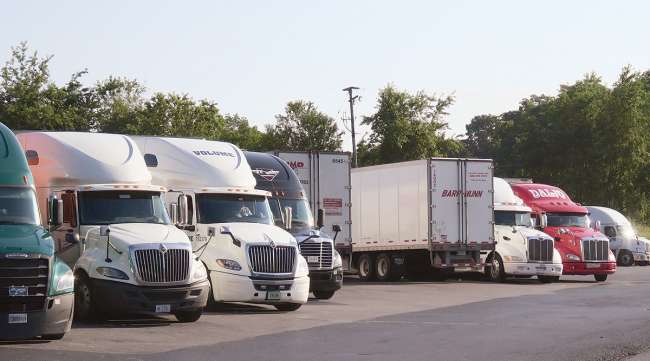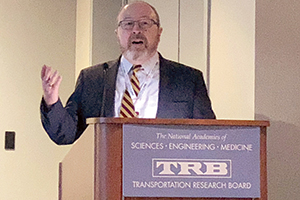Senior Reporter
Jason’s Law Survey Shows Truck Parking Remains a Challenge

[Stay on top of transportation news: Get TTNews in your inbox.]
A five-year update to a major parking availability survey for truck drivers had more participants and collected more data than the prior survey, but the bottom line is pretty much the same: There remains an overall critical shortage of parking spaces for truck drivers.
The good news was that from 2014-19, the number of truck parking spaces nationwide increased 6% in public areas and 11% in private areas, according to the Federal Highway Administration. FHWA’s survey included truck drivers, state departments of transportation, commercial vehicle state enforcement agencies, truck stop operators and owners, and port authorities.
The survey was made public at a teleconference Dec. 1.

Jeff Purdy at the Transportation Research Board's annual meeting in January 2020. (Eleanor Lamb/Transport Topics)
But the harsh reality is that most states continue to report that not many new public facilities or spaces are being developed, and challenges exist in planning, funding and accommodating truck parking, according to a presentation by Jeff Purdy of the FHWA Office of Freight Management and Operations.
In addition, there is a need for more business models and research and discussion, as well as local government involvement, Purdy said.
“Truck parking shortages are still a major problem in every state and region,” Purdy said. “Major freight corridors and large metro areas have the most acute shortages.”
RELATED: Truck Parking Shortage Costs Drivers $4,600 a Year, Expert Says

Home | Video | Heroes' Photo Gallery
Saluting the men and women of the trucking industry who kept America's essential goods flowing during the coronavirus pandemic.
Heroes: Peter Lacoste | Susan Dawson | James Rogers | Reggie Barrows | Kevin Cooper | Cesar Quintana Moreno
Purdy said truck drivers report that shortages exist at all times of day, week and year, mostly overnight and weekdays, but the survey showed that the problem has generated more awareness among stakeholders.
The Jason’s Law 2019 survey and assessment concluded that overall, about 313,000 truck parking spaces were available nationally — 40,000 at public rest areas and 273,000 at private truck stops.
The law is named for truck driver Jason Rivenburg, who in 2009 was unable to find a safe location to park and resorted to stopping at an abandoned gas station in South Carolina, where he was attacked and murdered. The survey is a requirement of the 2012 Moving Ahead for Progress in the 21st Century law.
How did turkey-to-table change this year? What obstacles were suppliers going through to get turkeys to grocery stores? Join us as we talk with J.J. Smith, President of Valley Proteins, about how staying open-minded and flexible helped his business of delivering turkeys persevere. Hear a snippet, above, and get the full program by going to RoadSigns.TTNews.com.
Jason’s Law was established to provide a national priority on addressing the shortage of long-term parking for commercial motor vehicles on the national highway system and improve safety. All 50 states and 11,600 drivers participated in the new survey, an increase from 8,000 in the 2014 report.
The new survey includes areas of shortages similar to 2014, those along Interstate 95 in the Northeast and Mid-Atlantic, and in the Chicago area and California.
However, new shortages emerged in additional locations since 2014, including throughout the entire I-95 corridor, Pacific corridors, states surrounding the Chicago region and other major freight corridors.
Unofficial/unauthorized parking continued to occur mostly on ramps and highway shoulders, and between 7 p.m. and 9 a.m., the survey showed.
About 98% of drivers reported problems finding safe parking, with challenges in every state and region. The most frequently reported periods for truck parking shortages by drivers were from 4 p.m. to 5 a.m. Monday through Thursday and from October through February.
Truck stop operators surveyed said their facilities operated at more than 100% capacity overnight, weekdays, and from May to October. The overwhelming majority said they do not plan to add more parking, do not monitor parking, offer reservations and do not charge for parking.
The top five states with the most spaces relative to miles are Indiana, Louisiana, Ohio, Kentucky and Oklahoma.

Roth
“I really hope that the next administration will continue to treat the issue with the seriousness that it deserves,” said Darrin Roth, vice president of highway policy for American Trucking Associations, speaking at the FHWA meeting.
“It’s not just about the safety of truck drivers, and those who share the road with them,” Roth said. “And it’s not only about the fact that truck drivers lose thousands of dollars in wages because they have to shut down early to find a safe place to rest, or about the billions of dollars added to the nation’s freight bills due to lost activity. It’s about all these things.”
He added, “It’s no wonder that the annual American Transportation Research Institute survey finds year after year that the parking shortage is one of truck drivers’ top concerns.”
Want more news? Listen to today's daily briefing:
Subscribe: Apple Podcasts | Spotify | Amazon Alexa | Google Assistant | More





